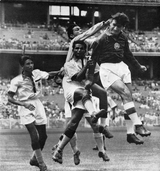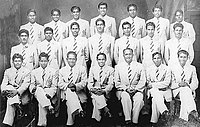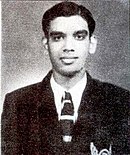
The India national football team represents India in men's international football and is governed by the All India Football Federation.

The South Korea national football team represents South Korea in men's international football and is governed by the Korea Football Association. South Korea has emerged as a major football power in Asia since the 1980s, having participated in ten consecutive and eleven overall FIFA World Cup tournaments, the most for any Asian country. Despite initially going through five World Cup tournaments without winning a match, South Korea became the first Asian team to reach the semi-finals when they co-hosted the 2002 tournament with Japan. South Korea also won two AFC Asian Cup titles, and finished as runners-up on four occasions. Furthermore, the team won three gold medals and three silver medals at the senior Asian Games.

The Lebanon national football team, controlled by the Lebanese Football Association (LFA), have represented Lebanon in association football since their inception in 1933. The squad is governed by the Asian Football Confederation (AFC) continentally, and FIFA worldwide. While Lebanon have yet to qualify for the FIFA World Cup, they have qualified three times to the AFC Asian Cup: they first participated in 2000, when they hosted the event. Lebanon's main venue is the Camille Chamoun Sports City Stadium in Beirut; however they also play in other locations such as the Saida Municipal Stadium in Sidon.

The Pakistan national football team represents Pakistan in men's international football in FIFA-authorized events and is controlled by the Pakistan Football Federation, the governing body for football in Pakistan. Pakistan became a member of FIFA in 1948 joining the Asian Football Confederation and its national team debuted in 1950.
The association football tournament at the 1956 Summer Olympics was won by the Soviet Union.
The CONCACAF Women's Olympic Qualifying Tournament was an international football (soccer) event in the North America, Central America and the Caribbean region, and was the qualification tournament for the Olympic Games.

The India women's national football team represents India at women's international football competitions and is governed by the All India Football Federation. Under the global jurisdiction of FIFA and governed in Asia by the AFC. India is also part of the South Asian Football Federation. The team was one of the best in Asia in the mid-1970s to early 1980s, when they became runners-up in the 1979 and the 1983 AFC Women's Asian Cup.

The Brazil national under-23 football team represents Brazil in international football competitions during Olympic Games and Pan American Games. The selection is limited to players under the age of 23, except three overage players. The team is controlled by the Brazilian Football Confederation (CBF). Brazil U23 is one of the most successful teams in the Olympic football tournament, having won it twice.

The India national under-23 football team represents India in international under-23 football and is controlled by the All India Football Federation (AIFF). A member of the Asian Football Confederation (AFC), the team is eligible to compete in the Summer Olympic Games, the AFC U-23 Asian Cup, and the Asian Games, subject to qualification.

The India national under-17 football team represents India in international football at the under-17 level. Controlled by the All India Football Federation, the governing body for football in India, the team is part of the Asian Football Confederation and the South Asian Football Federation.
This is a list of the Brazil national football team's competitive records and statistics.

Tan Sri Datuk Abdul Ghani bin Minhat was a football player who represented the team Selangor FA and Negeri Sembilan FA in the 1950s until the late 1960s. He played as a striker and winger while representing Malaya and Malaysia. He was known as the Raja Bola and is considered one of Malaysia's greatest football players.

Mariappa Kempaiah was an Indian professional footballer who played as a midfielder. He played for the India national team at two Olympic Games. Known for his "fitness, work rate and commitment", he was considered one of India's best midfielders.
The history of the India national football team dates back to the 1920s. They have never played in the World Cup although they qualified in 1950. They have had no entries in the tournament from 1950 onwards. India has never won the final of the Asian Championship but made it to the final in the 1964 AFC Asian Cup. They have only made three appearances since then.

The history of football in India is a long and detailed one, as it was the national sport at one time. The impetus for this was to unify the Indian Army. There is evidence of football games being played in the army since at least 1949. India is home to some of the oldest football clubs in the world, and the world's third oldest competition, the Durand Cup. There was a time when football in India was highly celebrated. The Indian football outfit was called the "Brazilians of Asia".

The Pakistan U-23 national football team is a youth football team operated under the Pakistan Football Federation. The team represents Pakistan in international youth football competitions in the Summer Olympics, AFC U-22 Asian Cup, Asian Games and the South Asian Games winning the 2004 and 2006 editions, as well as any other under-23 and under-22 international football tournaments, such as the AFC U-23 Asian Cup.
The following is a list of the India national football team's competitive records and statistics.

Results of India national football team from 1938 to 1959.
















